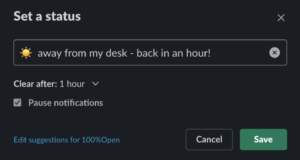A Remote Retrospective – Behind the Screen
Navigating the world from behind a screen.
For the past few years, 100%Open has worked with teams across the globe. Pre-COVID, this involved long-haul flights to new and interesting parts of the world, filling up conference rooms and halls with new and interesting people. These in-person workshops were full of energy, anticipation and excitement.
However, when these trips, both national and international, weren’t possible – for scheduling reasons or otherwise – we came back to what we knew all too well; online collaboration. Navigating different ideas, personalities and politics is what we do best, and over the years we learned how to do this, and do it well, from behind a screen.
But this wasn’t the only thing that we had already learned before the world started working from home. Our global projects allowed us to develop an infrastructure where collaborating across the globe/remotely was already standard procedure. We had Slack, Zoom, and Jam-boards tried and tested.
When I joined 100%Open, I was amazed at the different ways of working. Some people worked part-time, some people worked from home some days and at the studio on others, and some were out and about at meetings all days of the week. It was dynamic, oftentimes a little chaotic, and definitely an environment where clear communication was fundamental to our working style.
So when working from home was mandated, we already felt equipped for this. Isn’t this what we’ve basically been doing anyway? The pandemic simply allowed us the chance to knuckle down on what worked for us, and remove what didn’t.
This lead to the questions; what are the things that work for me in this new world? How did working from behind a screen work for me personally and for us as a team?
Slack: We continued to use Slack, but even more so. Where before it was a place for giving updates and communicating with our clients, it quickly became the backbone of our communications. Knowing which communications should be had on email (longer threads for continuity and ease of reference) and Slack (quick updates and staying in touch), was a trial and error process.

Main learning: Using the status button in Slack to communicate whether or not you’re available. This avoids the need to tell people every time you’re going to be away from your desk for your ‘mandatory exercise’ or grabbing some much-needed non-screen time.
Standups: These internal meetings were already standard procedure for the projects team, but had not yet been implemented across the board. Our wonderful People Person, Heli, suggested that to maintain our (sanity) comms, we have two daily standups, once in the morning and once in the afternoon. Not only did this help to keep the team connected, but it also added a solid start and end to the day in a situation where the boundaries between work and personal time blurred pretty easily.
Main learning: I haven’t always made this a priority (and sometimes still can’t due to other commitments), but always found these quick 15 minute meetings to be great for keeping tabs on who’s doing what, as well as on people’s general moods. This can get lost if we don’t have these informal catch ups, and keeps the human element at the forefront of our minds so when I go to send that email or slack, I know if I need to pay careful attention to its delivery.
Structure: Finally, another main area that came into my line of sight was how my days were structured. I found that I suddenly had more freedom to experiment with how and when I worked. Did I need to start at 9am or was I actually more productive at 7am? Do I need to keep working 9-5 or can I be more dynamic? It also forced me to take breaks where I needed to. For example, if I take a couple of hours out this afternoon, can I simply make up the hours this evening or tomorrow morning?
Main learning: Whilst doing all this experimenting, sometimes I wouldn’t keep people updated that this is what I was doing, which could cause friction at times. Keeping people updated and also checking that they were happy with it helped relieve any tension, and also made the hours I was working even more productive.
In the next blog, I’ll be reflecting on this shift as a whole and where I think it will lead me. In the meantime, feel free to check out the first instalment of this three part series on my WFH experiences here.